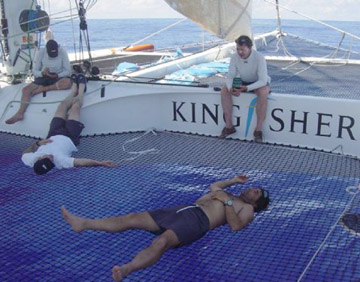 |
Photo of the Day: Around AloneFebruary 10 - Tauranga, NZ New Zealand Prime Minister Helen Clark fired the starting gun at 12:15 on Feb. 9, after a 15 minute delay to clear the starting area, for Leg 4 of the Around Alone Race.  Tommy Hilfiger Freedom America after the start of Leg 4 Photo Billy Black/www.billyblack.com After almost two days of sailing, the racers are enjoying mild conditions with wind from behind and close racing. In Class 1 (Open 60s), Frenchman Thierry Dubois in Solidaires is leading Swiss Bernard Stamm on Bobst Group-Armor Lux by about five miles. Class 2 (Open 50s) continues to be dominated by Californian Brad Van Liew and Tommy Hilfiger Freedom America. Leg 4 takes the fleet from Tauranga, New Zealand, around Cape Horn to Salvador, Brazil. At 7,850 nm, this is the longest leg and should take about a month. To follow their progress, see www.aroundalone.com. Before the restart, race chairman Sir Robin Knox-Johnston announced a new format for the next running, hoping to cut down on the time spent in port at each stopover and the wide variance between the yachts. His goal is to ensure solid sponsorship and more evenly matched funding for the competitors. This running is operating at a loss, which Sir Robin's company, Clipper Ventures, is absorbing. For a complete report on the announcement, see Michelle Slade's article on www.cupviews.com. |
Ocean Planet skipper Bruce Schwab reports, "What an exciting farewell from Tauranga and the start of Leg 4! There was an amazing turnout on the docks, complete with Maori warriors doing the fearsome 'Haka' dance, and a huge flotilla of boats out to view the start. We had a moderate reach for the first few miles and since then it has been all over the place and really light last night. It has been pretty much hand-to-hand combat so far with Bernard, Thierry and Graham, with Simone not far behind. In the light air drifting, we kept taking turns passing each other all night. This morning was stunning, with sunshine, dolphins, and the four of us Open 60s within a mile of each other - quite a sight." British competitor Emma Richards on Pindar, currently bringing up the rear of Class 1, reports, "First light this morning held a good sight of all six Class 1 boats and Brad [ahead in Class 2], all within sight of one another. But I seem to have sailed from one hole in the wind to another all day and have seen no one except Brad since. I am finally moving at six knots so I may get a speeding ticket soon. It has been very frustrating for certain moments, then very sociable with chats to some of the other competitors great for keeping morale up. With such flat calm seas, which show how little wind there is, it has shown up some amazing sea life! In fact one whale was swimming straight for me, just bobbing up and down, dead straight collision course. I had time to avoid it and grab my camera - this could be the first time I actually caught some sea life on it! I missed it by only a few feet and I think it suddenly realized I was there and dove." |
